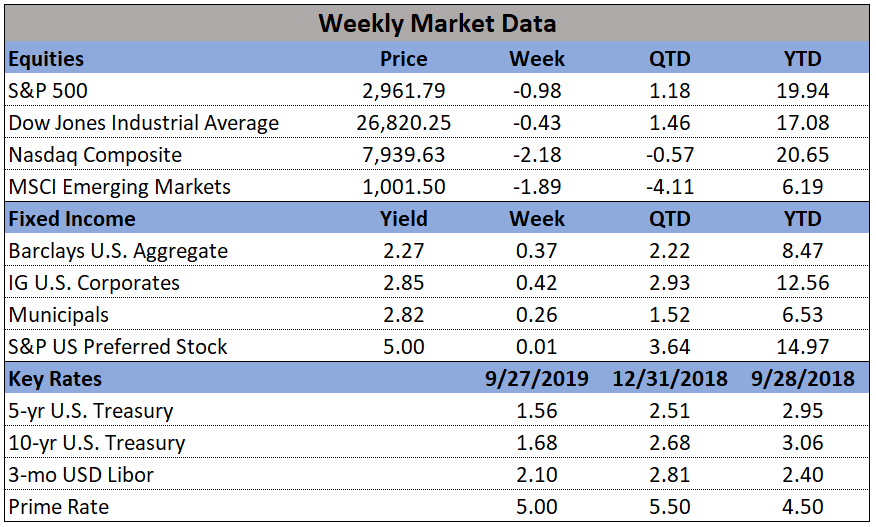In the markets:
U.S. Markets: The major U.S. stock indexes ended their streak of weekly gains at six and moved modestly lower as trade concerns returned to the forefront. Benchmarks traded in a narrow band until turning lower midweek as negative developments in the U.S.-China trade dispute hit news wires. The Dow Jones Industrial Average gave up 129 points last week to close at 27,875 a decline of -0.5%. The technology-heavy NASDAQ Composite retreated -0.3%. By market cap, the large cap S&P 500 declined -0.3%, while the mid cap S&P 400 and small cap Russell 2000 retreated -0.7% and -0.5%, respectively.
International Markets: Like the U.S., most international markets finished in the red as well. Canada’s TSX fell -0.4%, while the United Kingdom’s FTSE 100 finished the week up 0.3%. On Europe’s mainland, France’s CAC 40 declined -0.8%, Germany’s DAX fell -0.6%, and Italy’s Milan FTSE gave up -1.4%. In Asia, China’s Shanghai Composite finished down -0.2% and Japan’s Nikkei declined -0.8%. As grouped by Morgan Stanley Capital International, developed markets retreated -0.5%, while emerging markets fell -0.6%.
Commodities: Precious metals ended the week mixed with Gold giving up -0.3% and closing at $1463.60 an ounce, while Silver rose 0.3% to $17.00. Oil just barely managed its third consecutive week of gains, rising 0.1% to $57.77 per barrel of West Texas Intermediate crude. The industrial metal copper, viewed by analysts as a barometer of world economic health due to its myriad of uses, rose 0.4% last week.
U.S. Economic News: The number of Americans seeking first-time unemployment benefits remained near a 5-month high last week, the Labor Department reported. Initial jobless claims remained flat at 227,000, exceeding economists’ forecasts for just 218,000 new claims. The current level of claims remains at its highest level since last June. The monthly average of new claims, smoothed to iron out the weekly volatility, rose by 3,500 to 221,000. The number of people already collecting unemployment benefits, known as continuing claims, increased by 3,000 to 1.69 million. Those claims remain near their lowest level since the early 1970’s.
Sales of existing homes rebounded last month as low mortgage rates continued to provide a lift. The National Association of Realtors (NAR) reported sales of previously-owned homes rose 1.9% in October to a 5.46 million seasonally-adjusted annual pace. Year-over-year sales are up 4.6%. The reading barely missed economists’ forecast of an increase to 5.47 million sales. Prices increased across all regions of the country, and the median sales price ticked up 6.2% over the past year to $270,900. The number of months’ supply of new homes ticked down to just 3.9, said the NAR, far below the 6 months generally considered to indicate a “balanced” housing market.
Home builders are still quite optimistic about the future of the housing market, but the current state of the economy is weighing on sentiment. The National Association of Home Builders’ (NAHB) monthly confidence index declined one point to 70 this month. The reading is just off the 20-month high set in October. Despite the slight decline, index readings over 50 still represent improvement. Overall, home builders have continued to grow more confident throughout the year, and the NAHB said it was largely due to the more favorable interest rate environment that emerged in late summer.
Builders broke ground on new homes at a pace of 1.314 million last month, the Commerce Department reported. The reading was just short of the consensus forecast for 1.325 million starts among economists. In percentage terms, starts were up 3.8% from September and 8.5% higher than from the same time last year. Of note, building permits for privately-owned housing units were at a 1.461 million pace. That was 5% above September’s reading, and up 14.1% from last year. September’s reading was the fastest rate of building-permit authorizations recorded since 2007. Furthermore, October’s reading was the second best month for housing starts so far this year. Analysts attribute the optimism among builders to multiple factors including lower mortgage rates and an easing of tensions in the trade war between the U.S. and China.
The University of Michigan (UofM) reported that sentiment among the nation’s consumers rose in November. UofM’s reading of its consumer-sentiment index was 96.8, 1.3 points above October’s reading. Economists had estimated the reading would remain unchanged at 95.7. In the details of the report, consumers’ views on current conditions declined to 111.6 in November from 113.2 in October, while the measure of their expectations for the future rose 3.1 points to 87.3. Many economists and Federal Reserve officials think the U.S. economy can avoid a recession because of the strong consumer sector. The holiday shopping season will be a good test for this thesis.
Manufacturing activity in the mid-Atlantic region improved this month according to data from the Federal Reserve Bank of Philadelphia. The Philly Fed’s manufacturing index rose 5 points in November to 10.4, but analysts noted some of the details remained soft. While firms were generally optimistic about the future, the indicators for new orders, shipments and employment all fell from their readings last month, while the index of future activity rose 2 points to 35.8.
Research firm IHS Markit reported both its flash manufacturing and services Purchasing Managers’ Indexes (PMI) improved this month. For the manufacturing sector, Markit reported its index rose 0.9 point to 52.5 in November—its fastest gain since April. Meanwhile, its flash services sector PMI index rose to 51.6 from 50.6. That was that reading’s fastest increase since July. Chris Williamson, chief business economist at IHS Markit stated, “A welcome upturn in the headline index from the flash PMI adds to evidence that the worst of the economy’s recent soft patch may be behind us.” Markit’s flash estimates are typically based on approximately 85-90% of total survey responses each month, with the final number coming out later.
Federal Reserve officials were more upbeat about the state of the economy in late October than they were just six weeks earlier, according to minutes from the Federal Reserve’s latest policy meeting. The minutes stated officials “generally viewed the economic outlook as positive” and that “Uncertainties associated with trade tensions as well as geopolitical risks had eased somewhat, although they remained elevated.” Officials also referred to the economy as “resilient” in the face of multiple headwinds. At their meeting, the Fed voted 8 to 2 to trim rates by a quarter point. It was the third straight meeting with a rate cut bringing the benchmark fed funds rate to a range of 1.5-1.75%. The minutes stress that the Fed would be watching the data closely and policy was not on a pre-set course. Powell told Congress last week that “if developments emerge that cause a material reassessment of our outlook, we would respond accordingly.”








